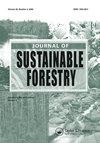Effect of Drought Stress on Physio-biochemical Traits and Secondary Metabolites Production in the Woody Species Pinus Halepensis Mill. At a Juvenile Development Stage
IF 1.8
4区 农林科学
Q3 FORESTRY
引用次数: 10
Abstract
ABSTRACT The characterization of the drought stress responses of plants is essential to understand the interactions of these effects with key life processes, such as growth and reproduction. The capability of plants to respond to abiotic stress is associated with their plasticity as well as the adaptableness of plant traits to fluctuating bioclimatic conditions. In this study, the response of Pinus halepensis seedlings to the different water irrigation regimes was assessed based on various ecophysiological, biochemical, and metabolic traits. This approach aims to identify different traits capable of predicting the ability of formerly uncharacterized seedlings to cope with drought stress. The obtained results revealed that drought stress affects the vital metabolic processes in Aleppo pine plants, such as transpiration, photosynthesis, and respiration at their early development stage. These variations were accompanied by changes in chlorophyll pigment contents and an accumulation of organic solutes (sugar and proline). Both drought stress levels induced an increase over the control of the amounts of total secondary metabolites and essential oil contents. These findings are of particular interest in the comprehension of seedlings response to drought stress which provides valuable background knowledge for the success of reforestation programs based on this woody species.干旱胁迫对木本树种Halepensis Mill生理生化性状及次生代谢物产量的影响处于幼年发育阶段的
了解干旱胁迫对植物生长和繁殖等关键生命过程的影响,对了解干旱胁迫对植物的影响至关重要。植物对非生物胁迫的响应能力与植物的可塑性以及植物性状对波动的生物气候条件的适应性有关。本研究基于不同的生理、生化和代谢性状,评价了halepensis幼苗对不同灌溉方式的响应。该方法旨在确定能够预测以前未表征的幼苗应对干旱胁迫能力的不同性状。研究结果表明,干旱胁迫影响了阿勒颇松植物发育早期的蒸腾、光合和呼吸等重要代谢过程。这些变化伴随着叶绿素色素含量的变化和有机溶质(糖和脯氨酸)的积累。两种干旱胁迫水平均导致次生代谢物总量和挥发油含量高于对照。这些发现对理解幼苗对干旱胁迫的反应特别有意义,为基于这种木本物种的重新造林计划的成功提供了有价值的背景知识。
本文章由计算机程序翻译,如有差异,请以英文原文为准。
求助全文
约1分钟内获得全文
求助全文
来源期刊

Journal of Sustainable Forestry
Social Sciences-Geography, Planning and Development
CiteScore
3.90
自引率
12.50%
发文量
42
期刊介绍:
Journal of Sustainable Forestry publishes peer-reviewed, original research on forest science. While the emphasis is on sustainable use of forest products and services, the journal covers a wide range of topics from the underlying biology and ecology of forests to the social, economic and policy aspects of forestry. Short communications and review papers that provide a clear theoretical, conceptual or methodological contribution to the existing literature are also included in the journal.
Common topics covered in the Journal of Sustainable Forestry include:
• Ecology, management, recreation, restoration and silvicultural systems of all forest types, including urban forests
• All aspects of forest biology, including ecophysiology, entomology, pathology, genetics, tree breeding, and biotechnology
• Wood properties, forest biomass, bioenergy, and carbon sequestration
• Simulation modeling, inventory, quantitative methods, and remote sensing
• Environmental pollution, fire and climate change impacts, and adaptation and mitigation in forests
• Forest engineering, economics, human dimensions, natural resource policy, and planning
Journal of Sustainable Forestry provides an international forum for dialogue between research scientists, forest managers, economists and policy and decision makers who share the common vision of the sustainable use of natural resources.
 求助内容:
求助内容: 应助结果提醒方式:
应助结果提醒方式:


